Bacterial Infection in Fish: Causes, Symptoms, and Prevention
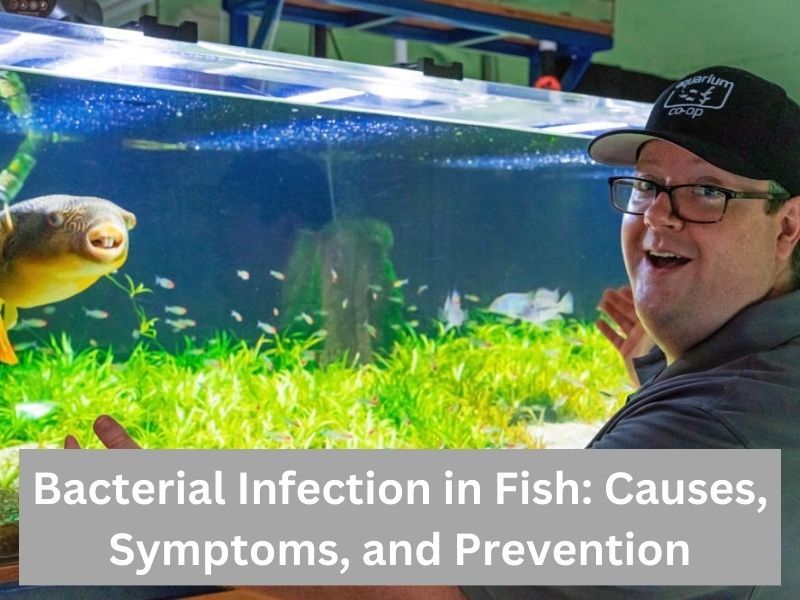
For both home aquariums and aquaculture, fish health is essential. If left untreated, bacterial infection in fish can seriously impair their health and have dire repercussions. With the help of this guide, fish owners and aquarium enthusiasts will be able to identify bacterial diseases, comprehend their origins, and take appropriate action.
Symptoms of bacterial infection in fish
While different types of infections in fish can be caused by various pathogens (bacteria, viruses, fungi, parasites), they often share common symptoms. These signs of illness include infections usually caused by three types of bacteria: Aeromonas, Pseudomonas, and Mycobacterium.
Behavioral Changes
- Lethargy: Fish infected with bacteria often exhibit significant reduced activity. They may remain stationary at the bottom of the tank or pond, showing little interest in their surroundings. This lethargy indicates general malaise and is a common early sign of infection.
- Isolation: Affected fish may separate themselves from their school or group. They might seek out hiding spots such as plants, rocks, or decorations. This behavior is typically a response to stress or discomfort.
- Loss of Appetite: Infected fish often show a marked decrease in feeding activity. They may ignore food completely or eat much less than usual. This loss of appetite can lead to weight loss and further weaken the fish, making them more susceptible to other infections.
- Erratic Swimming: Disoriented or erratic swimming behaviors, such as swimming in circles, sudden darting movements, or difficulty maintaining a straight path, can be indicative of neurological impact or severe stress caused by the infection.

Physical Symptoms
- Skin and Fin Abnormalities:
- Ulcers: One of the hallmark signs of these infections is the development of ulcers on the skin. These open sores can vary in size and may be surrounded by red, inflamed tissue. They often appear on the body but can also be found on the head, fins, or tail.
- Hemorrhaging: Red spots or streaks due to subcutaneous bleeding are common. These hemorrhages are usually seen near the base of the fins or where ulcers are present.
- Fin Rot: The edges of the fins may appear frayed, eroded, or discolored. In severe cases, the fins can deteriorate completely, leading to significant fin loss.
- Excess Mucus Production: The skin may produce an abnormal amount of mucus, which can appear as a slimy coating on the fish. This excess mucus is a protective response to the infection but can further complicate the fish’s condition.
- Gastrointestinal Signs:
- Bloating: Abdominal swelling or bloating is a common symptom, often due to internal infections or inflammation. This can cause the fish to have difficulty swimming and maintaining balance.
- Discoloration: The abdomen or body may change color, often becoming darker or, in some cases, pale. This discoloration is a sign of internal distress and infection.
- Respiratory Distress:
-
Rapid Breathing: Infected fish may exhibit rapid gill movements or labored breathing, indicating respiratory distress. This can be due to gill damage or general systemic stress.
-
Gasping at the Surface: Fish may come to the surface more frequently to gulp air, which can be a sign of compromised gill function or oxygen deficiency in the water.
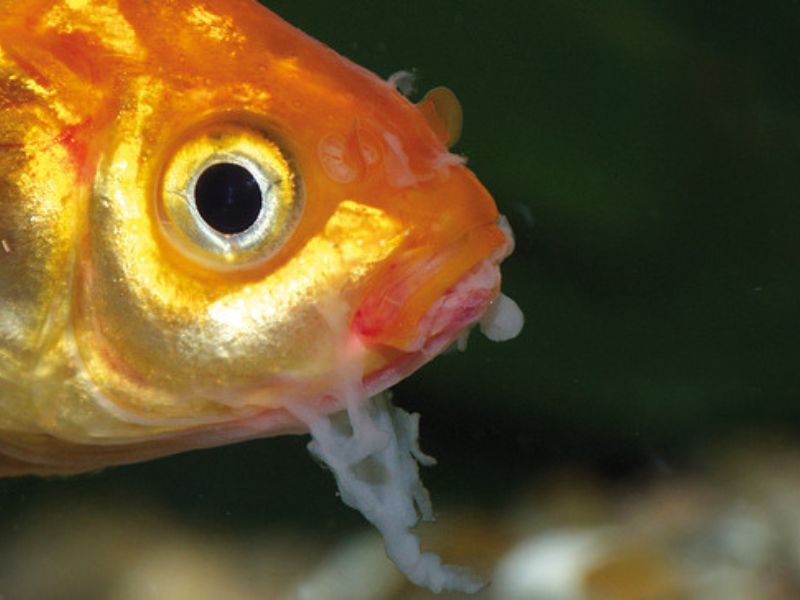
In summary, most of the symptoms of behavioral changes and physical changes of Aeromonas, Pseudomonas, and Mycobacterium are the same, however, in the next section we will clarify some key differences that help distinguish/diagnose these diseases accurately. this type of bacteria and there is a specific treatment for each type.
Common Bacterial Types and Symptoms of Bacterial Infection in Fish
To gain a deeper understanding of fish diseases, through a special report on 2022 reseach on Bacterial Diseases of Fish by ByBarbara D. Petty, DVM; Ruth Francis-Floyd, DVM, DACZM; Roy P. E. Yanong, VMD, we will clearly analyze these 3 types of bacteria through the list.
Aeromonas Infections
Based on 1998 study on Aeromonas Bacterial Infections – Motile Aeromonad Septicemia by A.C. Camus, R.M. Durborow, W.G. Hemstreet3, R.L. Thune and J.P. Hawke, Aeromonas infection causes non-specific disease symptoms that can be easily mistaken with other infections. Here are some specific symptoms that fish owners should pay attention to:
Septicemia
Septicemia, also known as Bloodstream infection exhibits these symptoms on fish:
- Systemic Infection: Aeromonas infection in fish can enter the bloodstream, leading to a systemic infection known as septicemia. This condition can cause widespread inflammation and damage to various organs.
- Fever: Although difficult to detect in fish, septicemia can cause an increase in body temperature, leading to changes in behavior and physical condition.
- Hypotension: Low blood pressure can result from severe septicemia, causing lethargy and weakness.
- Rapid Heartbeat: The fish’s heart may beat faster as it attempts to cope with the infection, although this is not easily observed.
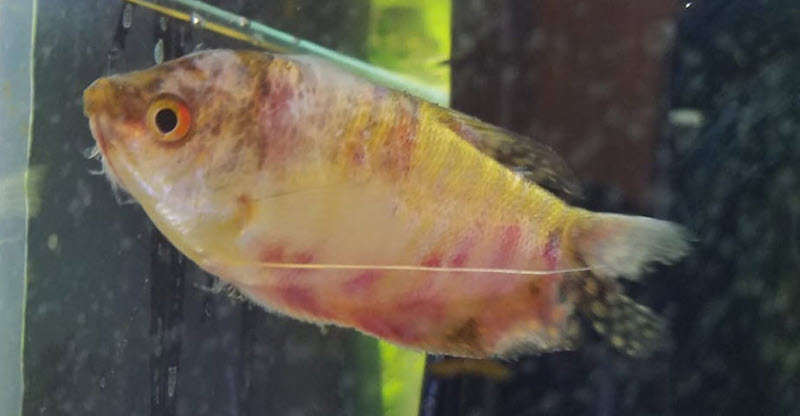
Localized Infections:
- Wound Infections: Open wounds or scratches can become infected, leading to further complications. These infected wounds may not heal properly and can become sites of secondary infections.
- Fin Infections: Infections may localize in the fins, causing them to become inflamed, discolored, and susceptible to further damage.

Invasive Infections:
- Meningitis: Although rare, Aeromonas can cause inflammation of the membranes around the brain and spinal cord, leading to severe neurological symptoms such as loss of coordination, erratic swimming, and seizures.
- Necrotizing Fasciitis: This is a severe, rapidly progressing infection that can lead to tissue death. This condition is rare but extremely serious, often requiring immediate intervention.
These symptoms can appear immediately, within 1-3 days, and may persist until the infection is treated. If left untreated, Aeromonas infections can be lethal, producing severe tissue destruction and systemic sickness in fish.
Fish bacteria can multiply rapidly, causing widespread infection and, in severe cases, death. Prompt treatment is critical to minimizing damage and increasing the chances of recovery.
Pseudomonas Infections
As maintained by a study in 2022 on Pseudomoniasis in Fish by Jessie Sanders, Pseudomoniasis in fish is similar to many other bacterial illnesses. These widespread symptoms are not unique to a Pseudomonas infection, but are present in any bacterial fish sickness.
Sepsis
- Systemic Infection: Pseudomonas can enter the bloodstream, leading to a systemic infection known as sepsis. This condition causes widespread inflammation and can severely damage internal organs.
- Fever: Although challenging to detect in fish, sepsis can cause an increase in body temperature, leading to changes in behavior and physical condition.
- Hypotension: Low blood pressure resulting from severe sepsis can cause lethargy and weakness.
- Rapid Heartbeat: The fish’s heart may beat faster in response to the infection, although this is not easily observable.
Localized Infections
Similar to Aeromonas bacteria, Pseudomonas infections also have similar symptoms of localized infections:
- Wound Infections: Pseudomonas can infect open wounds or scratches, preventing them from healing properly and potentially leading to further complications. These infected wounds can become sites of secondary infections.
- Fin Infections: The fins may become inflamed and discolored, often resulting in fin rot or complete fin loss.
Invasive Infections
- Meningitis: In rare cases, Pseudomonas bacterial infection in fish can cause inflammation of the membranes around the brain and spinal cord, leading to severe neurological symptoms such as loss of coordination, erratic swimming, and seizures.
- Necrotizing Fasciitis: A severe, rapidly progressing infection that can lead to tissue death. Although rare, this condition is extremely serious and requires immediate intervention.

As maintained by research in 2023 Prevalence and Antibiotic Resistance Phenotypes of Pseudomonas spp. in Fresh Fish Filets by Nesrine Ben Mhenni et. al, symptoms typically occur within 2-4 days and last till addressed. Untreated Pseudomonas infections can cause significant internal damage and death. The pathogen can spread rapidly, overwhelming the fish’s immune system and resulting in systemic failure. Early detection and treatment are critical to avoiding serious consequences.
Mycobacterium Infections
According to the 2011 research study on Mycobacteriosis of Fish – Alaska Fish and Game, non-specific scale loss, skin ulceration, emaciation, spinal abnormalities, and ascites are all common clinical symptoms of mycobacteriosis. Here is the full breakdown:
Granulomas
- Internal Granulomas: Mycobacterium infections often lead to the formation of granulomas in internal organs such as the liver, kidneys, and spleen. These granulomas can cause organ dysfunction and are typically identified during necropsy.
- External Granulomas: Granulomas may also form on the skin, appearing as firm lumps or nodules.
Skeletal Deformities
- Bone Deformities: Bone deformities in fish often result from poor water quality, nutritional deficiencies, genetic factors, physical trauma, or diseases. Chronic infections can lead to skeletal deformities, including abnormal growth of bones and spinal curvature. These deformities can affect the fish’s ability to swim and feed properly.
Neurological Signs
Poor water quality, diseases, parasites, toxins, nutritional deficiencies, or physical trauma cause confusion, disorientation, and loss of coordination are common neurological symptoms. In severe cases, fish may exhibit twitching, convulsions, or seizures.
Internal Organ Damage:
Bacterial infections can wreak havoc on the internal organs of fish, leading to a cascade of pathological changes and potentially fatal consequences. Below are some symptoms:
- Organ Enlargement: Infected fish may have an enlarged liver, spleen, or other internal organs, often due to granuloma formation.
- Multi-organ Dysfunction: Severe infections can lead to widespread organ damage and dysfunction, contributing to the overall decline in the fish’s health.

Chronic Wasting
Unlike bacterial infections, chronic wasting disease is a brain disorder caused by abnormal proteins, not bacteria. Here are some symptoms that fish owners should attend to:
- Weight Loss: Chronic infections with Mycobacterium often result in significant weight loss and muscle wasting. The fish may appear emaciated despite normal or increased feeding behavior.
- Poor Body Condition: Infected fish may have a generally poor body condition, with sunken eyes, a hollowed-out appearance, and a rough or unhealthy-looking skin texture.
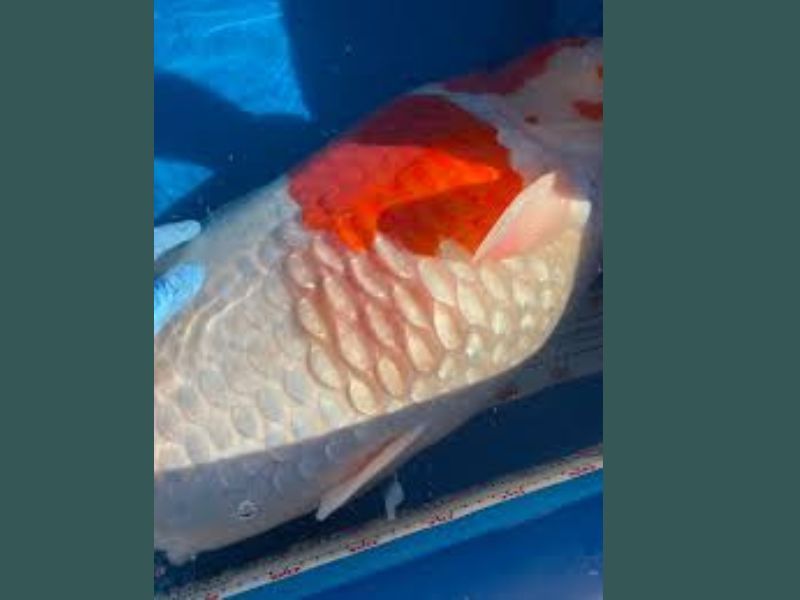
According to a 2013 study of the Center for Food Security & Public Health Mycobacterium marinum Infections in Fish, Mycobacterium infections are sluggish to progress, thus symptoms may take weeks to months to appear. If left untreated, the infection can be fatal, causing severe systemic sickness and organ failure.
Mycobacterium infections are chronic, which implies that fish can suffer for extended periods of time, frequently with progressive decreases in health and vitality. Early intervention is critical to avoiding long-term damage and increasing survival rates.
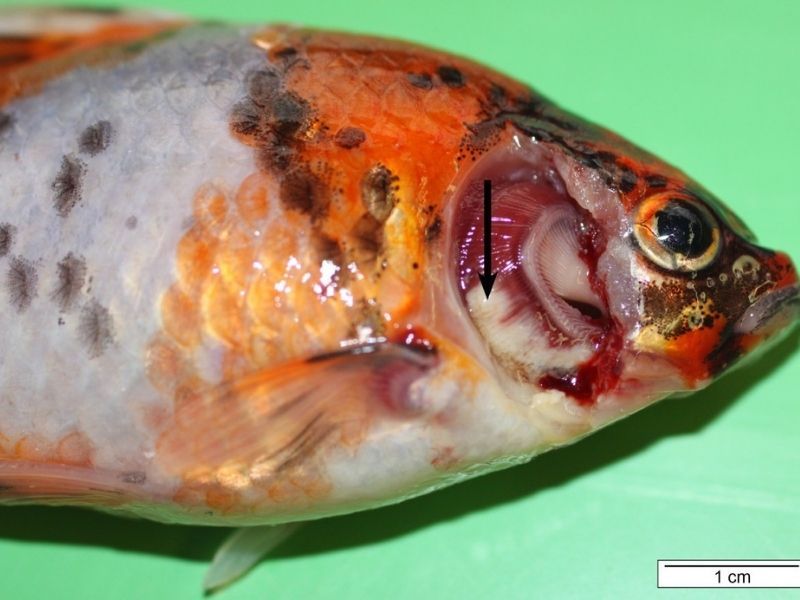
Contributing Factors Causing Bacterial Infection in Fish
Poor Water Quality
Poor water quality strains and weakens fish’s immune systems, leaving them more vulnerable to diseases. It generates high amounts of ammonia, nitrites, and nitrates, along with low oxygen levels, which provide an environment ideal for bacterial development. Regular monitoring and maintenance of water parameters is critical for preventing bacterial outbreaks.
Overstocking
Overstocking tanks generate trash and degrade water quality, fostering bacterial growth. High fish density generates more organic waste, which can clog the filtration system and damage water quality. It also generates stress in the fish, making them more susceptible to illnesses. Providing enough space for each fish and avoiding overcrowding are critical preventive measures.

Stress
Stress from environment changing can weaken fish, leaving them more susceptible to illness. Stress causes physiological changes that inhibit the immune system, limiting the fish’s ability to fight infections.
These alterations include sudden changes in water temperature, pH, or salinity, aggressive tank mates, and insufficient hiding places. Minimizing stress through gentle handling, stable environmental conditions, and good tank layout can help fish stay healthy.
Parasites
Parasites can produce wounds on fish, which can serve as entrance routes for bacteria, leading to illnesses. Ichthyophthirius multifiliis (Ich), flukes, and lice. These infections can cause skin and gill damage in fish, allowing germs to invade.
Secondary bacterial infections can be avoided by checking parasite infestations on a regular basis and treating them promptly. Quarantining new fish and administering antiparasitic drugs are effective parasite control measures.
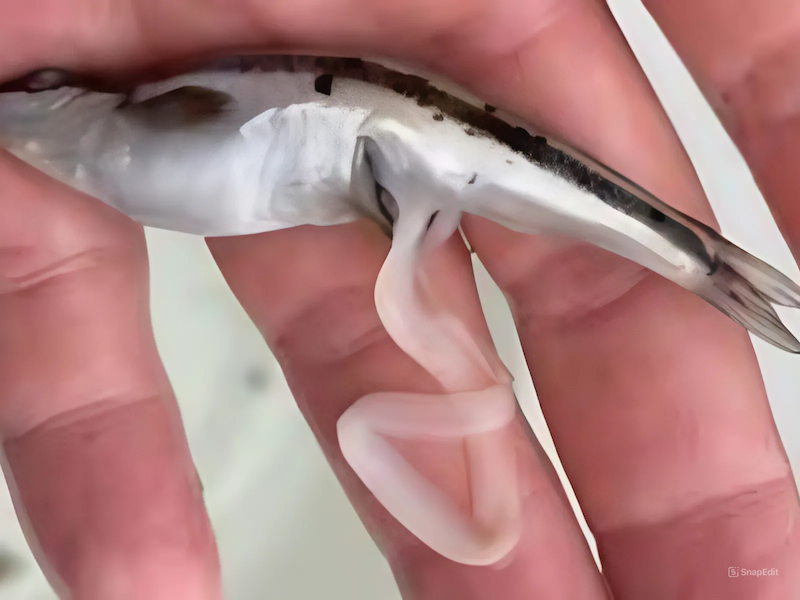
Treatment Options
Common Treatments
There are several common treatments for bacterial infections in fish:
- Antibiotics: According to research in 2021 impact of antibiotics on fish bacteria by David Bogert, medications can be added to the fish’ diet. Effective antibiotics you can use for infection treatment are: Amoxicillin, kanamycin, and oxytetracycline. To avoid antibiotic resistance, carefully follow the dosage directions and finish the entire course of therapy.
- Salt Baths: Salt baths aid in the promotion of healing and the treatment of external infections. Depending on the severity of the infection, submerge the diseased fish in a solution of non-iodized salt for a brief amount of time – usually in 10 – 30 minutes. Watch the fish while it bathes and try not to leave it in the water too long.
- Improved water conditions: Fish can recover if the ideal water conditions are maintained. An environment that is conducive to healing can be produced with regular water changes, filtration upkeep, and water parameter modifications. In order to lessen tension and accelerate healing, think about utilizing vitamins or water conditioners.

Specific Treatments
Different bacterial infections may require specific treatments:
- For Aeromonas: Antibiotics such as amoxicillin or oxytetracycline can treat Aeromonas infections. To stop reinfection, treatment needs to be started right away, and water quality needs to be regularly checked. To stop the virus from spreading, isolate the afflicted fish.
- For Pseudomonas: Antibiotics like kanamycin are used in the treatment of Pseudomonas infections. To aid in healing, take care of underlying stressors and enhance the quality of the water. It might be essential to conduct follow-up treatments and routine monitoring to guarantee total eradication of the bacteria.
- Understanding Infection of Fish Bacteria: Causes, Symptoms, and Prevention of Mycobacterium Infections
Guidelines for Bacterial Infection in Fish Treatment
Proper Use of Medications
- Accurately diagnose the type of bacterial infection to choose the appropriate antibiotic.
- Follow dosage instructions from the manufacturer or veterinarian carefully.
- Administer antibiotics through bath treatments, oral methods, or injections, depending on the infection.
- Maintain optimal water quality in the quarantine tank to enhance treatment effectiveness.
Monitoring Recovery
- Observe the fish daily for changes in behavior, appetite, and physical healing.
- Regularly check and adjust water parameters such as temperature, pH, and ammonia levels.
- Continue the full course of medication even if the fish appears to recover early.
- Gradually reintegrate the fish into the main tank while monitoring for signs of relapse.
- Implement good husbandry practices to prevent future infections.

Prevention of Bacterial Infections
Early Diagnosis of Bacterial Infection in Fish
Proper diagnosis is essential for effective treatment because it allows for the selection of the most appropriate antibiotic, which targets the specific bacterium causing the infection. Accurate identification avoids pharmaceutical misuse, lowering the danger of antibiotic resistance and increasing the likelihood of complete recovery. Here are some steps for early diagnostic:
- Visual Inspections: Keep an eye out for any indications of infection in fish. Watch for alterations in eating patterns, behavior, and appearance. The spread of illnesses can be prevented by routine observation and early identification.
- Laboratory Testing: In severe situations, testing in the lab can pinpoint the precise germs at play. To provide a precise diagnosis and inform treatment choices, samples of afflicted tissues, blood, or water can be taken for bacterial culture and sensitivity testing. In difficult circumstances, speaking with a veterinarian or fish health professional is advised.
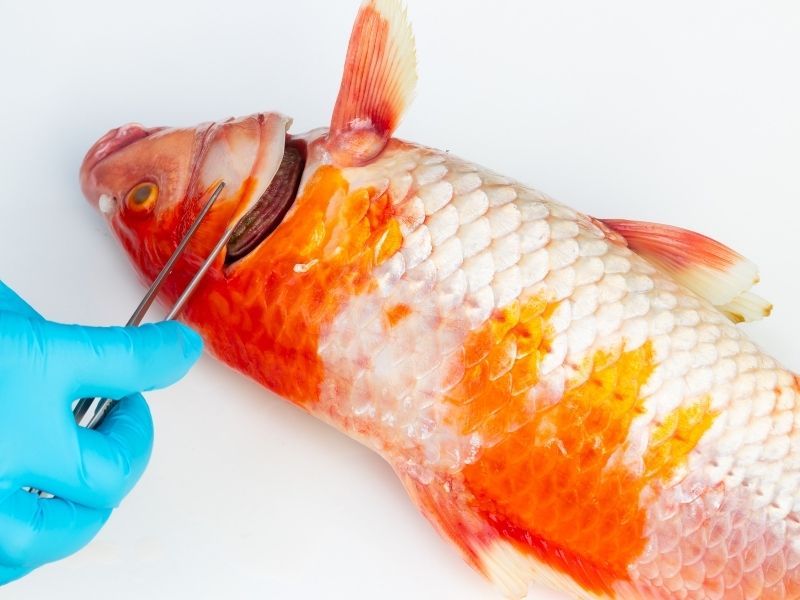
Maintaining Optimal Water Quality
Good water quality is the first line of defense against bacterial infections:
- Filtration: To get rid of trash, make sure your tank has an effective filtration system. Effective chemical, biological, and mechanical filtration can maintain clean, pollutant-free water. For optimum efficiency, filters require routine maintenance, which includes media replacement and cleaning.
- Regular Water Changes: To ensure cleanliness, periodically replace a portion of the water. Frequent water changes supply vital minerals, neutralize stored pollutants, and keep water parameters steady. Aquarists are advised to aim for 10-20% partial water changes weekly, depending on the size of the tank and the density of the stock.
- Monitoring Parameters: Make sure you routinely test the pH, ammonia, nitrites, and nitrates in your water. Keep an eye on the main indications of water quality using dependable test kits or electronic meters and make necessary adjustments. Reducing the danger of infections and preventing stress can both be achieved by maintaining stable and suitable water conditions.
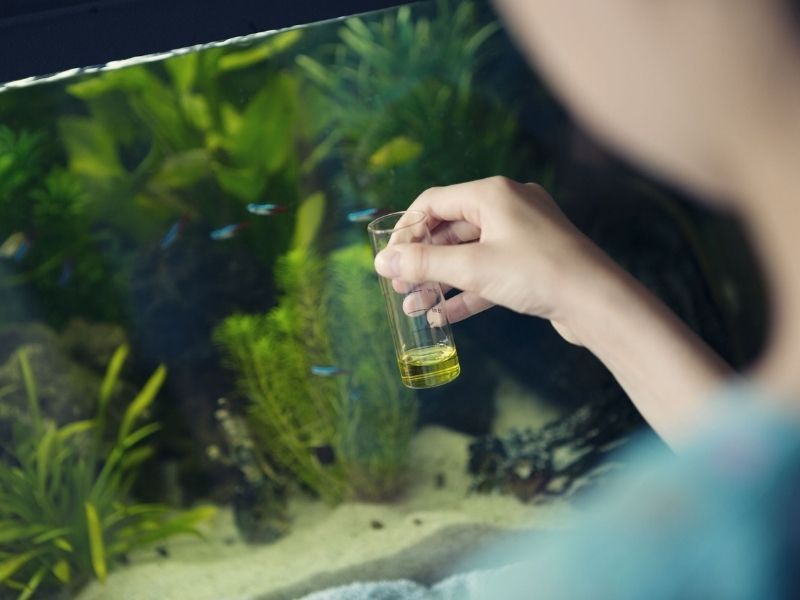
Quarantining Fish
Quarantining new fish before adding them to your main tank can prevent the introduction of diseases:
- Separate Tank: Keep new fish in a separate tank for at least two weeks. A quarantine tank should have similar water conditions to the main tank and include hiding spots to reduce stress. Monitor the new fish for any signs of illness during this period.
- Observation: Monitor the new fish for any signs of illness. Observe behavior, appetite, and physical appearance. Any signs of disease should be treated in the quarantine tank before introducing the fish to the main tank.

Stress Reduction Techniques
Reducing the fish’ stress can help prevent infections, refer to some techniques below:
- Proper Diet: Feed your fish a balanced diet to maintain their health. A varied diet that includes high-quality flakes, pellets, frozen, and live foods can support immune function and overall health. Avoid overfeeding, as uneaten food can degrade water quality.
- Appropriate Tank Mates: Ensure tank mates are compatible to avoid stress from aggression. Research species compatibility and avoid housing aggressive or territorial fish with more docile species. Providing adequate hiding spots and territory can reduce conflicts.
- Avoiding Overstocking: Keep the fish population within the tank’s capacity. Overstocking leads to increased waste production and competition for resources, causing stress and deteriorating water quality. Follow recommended stocking guidelines based on tank size and filtration capacity.

The Bottom Line
Bacterial infection seriously threatens fish health, whether the fish are kept in home aquariums or farmed. Fish fans may safeguard their aquatic pets from hazardous diseases by being aware of common bacterial types, identifying symptoms, and taking preventive steps. Maintaining a healthy habitat for fish benefits their health, makes fish keeping more enjoyable, and protects them from bacterial infection in fish.



